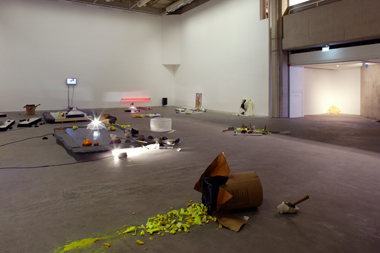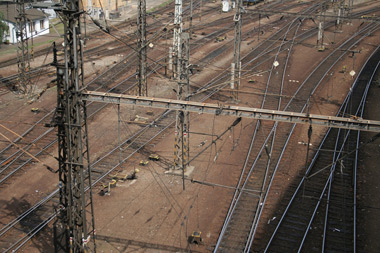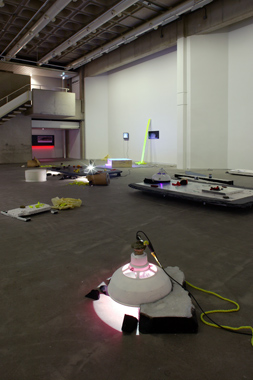The Curated Visual Art Award Exhibition Part 1: Conor McFeely The Case of the Midwife Toad (the unrepeatable experiment) Douglas Hyde Gallery Laura McGovern There were four recipients of the Curated Visual Arts Award: Brendan Earley, Bea McMahon, Conor McFeely and Factotum. Part 1 of the exhibiton takes place in the Douglas Hyde Gallery and showcases the work of Conor McFeely and Factotum. Gallery 1 is given over to McFeely’s The Case of the Midwife Toad (the unrepeatable experiment) and a film produced by Factotum will be shown in March. The awards are “designed to enable the selected artists to produce pivotal work that will advance thier own practice."
 |
Conor McFeely, The Case of the Midwife Toad (the unrepeatable experiment),2007, installation shot; courtesy the Douglas Hyde Gallery |
The Case of the Midwife Toad (the unrepeatable experiment) is an exhibition in a variety of mediums; video installations, photography, sculpture all play to great success against a variety of lighting techniques. For this exhibiton the Douglas Hyde is void of any natural light; this is necessary as McFeely uses ultraviolet lights and strip lighting throughout the exhibition. The Case of the Midwife Toad (the unrepeatable experiment) is McFeely’s response to a series of experiments carried out by Paul Kammerer, an Austrian biologist who set out to validate the theory of Lamarckianism, the idea that acquired characteristics can be inherited. Kammerer used a breed of toad called the Midwife Toad to ‘prove’ this theory. If Kammerer were to succeed, he would therefore be challenging Darwinism, much to the science world’s disapproval. Kammerer claimed he succeeded in proving the theory of Lamarackianism, but when his results were shown to be falsified, Kammerer committed suicide.
In 1971 Arthur Koestler re-examined the case in his book The Case of the Midwife Toad (the title of which being where the exhibition gets it name) and found that Kammerer’s work had been sabotaged, clearing Kammerer’s name. Koestler believed that Kammerer’s work was likely to have been tampered with by Nazi sympathizers due to the nature of the work involved and the Socialist stance Kammerer ardently took. Kammerer worked in a time and place when genealogy was a dangerous topic to be involved in, due to its issues surrounding race. The Case of the Midwife Toad (the unrepeatable experiment) is McFeely’s response to Kammerer’s plight but as he points out, “It is not an attempt to illustrate an historical event, more an improvisational response to a ‘selected’ subject where the work is both dependent on its origins and freely autonomous at the same time." [1] Whilst this may be the case, it is hard to push back the political and social implications of gentic exploration during that time period and the subsequent uses of eugenics thereafter.
As expected, toads are a major feature of the exhibition. There is an abundance of plaster-casts of toads in the gallery, some half-formed, some astride sticks, along with photographic reproductions of mutated toads on graph paper. Overall, McFeely has capitalised on the open space that the Douglas Hyde offers, but he does so in such a way that the gallery’s proportions feel distorted; it’s extensive ceiling height feels lower while the floor space feels wider.
 |
Conor McFeely, The Case of the Midwife Toad (the unrepeatable experiment),2007, installation shot; courtesy the Douglas Hyde Gallery |
Other elements are also explored. Knives, forks and spoons covered in a dark green felt appear to be carelessly scattered upon the floor. Images of rusty nails against graph paper also feature stongly, often as large prints, torn at the corners on the floor or very small images printed on graph paper. The most effective use of this motif was a large-scale poster print of it, pinned into the wall by clear plastic drawing pins mounted against a larger sheet of plain black paper also held by drawing pins. Directly beneath this is a red strip light; it is perfection contrasted with the chaos of objects laid out on the floor. From this installation the viewer is led down, under the stairs, past waxed paper upon which lie piles of dust in varying sizes. The paper appears to emerge from a large black metal box with a grate on one side, inside which hung two black UV lightbulbs. This leads then to the most straightforward piece on show, a photograph of multiple railway lines and their junctions. As an image alone it works; the eye is drawn along the tracks and the overhead lines, and the limited use of colour sits well against the strong colours so predominant elsewhere in the exhibition.
There are two video pieces included in this exhibition. The first can be seen to consist of three sections whilst the other is more abstract and graphic in its approach. Within the first mentioned three sections these consist of i) a sequence of elements of the natural landscape, trees and streams etc, ii) a series of close-ups of different words extracted from a single page of text from a book, and iii) the last, a sequence of a man in bed. The latter shows a man alseep, layered over which are images of birds; they appear to pick away at the man as he lies in slumber, but he is disturbed from his sleep and finds it difficult to rest again. Beside the video screen there is a photograph of the man asleep (UV lights are used to illuminate this and other objects surrounding it). The reasoning behind the inclusion of the same scene as both a still and moving image is unclear, especially as parallels cannot be easily drawn between the image and the basis of the exhibition. The text (see ii) above) is replicated elsewhere in the form of a large poster print. It is a paragraph from a book that begins by describing the weather; it subsequently becomes overly descriptive, commenting on air pressure, wind velocity, etc. Its relationship to the exhibition is unclear until one reaches the end of the paragraph: “In short, to use an expression that describes the facts pretty satisfactorily even though it is somewhat old-fashioned; it was a fine August day in the year 1913." The only connection is that 1913 was during the height of Kammerer’s career, but it is so loose a connection that its value is unclear.
The second video piece appears like early experimentation in Photoshop. Working as if with layers, McFeely presents us with them in multiples; graph paper, an eye opening and closing, a moth and hand-written text. This piece felt rather twee, and I found it did not add in analysis or substance to the exhibition.
 |
| Conor McFeely, The Case of the Midwife Toad (the unrepeatable experiment),2007, installation shot; courtesy the Douglas Hyde Gallery |
The calculated chaos of a laboratory is apparent throughout this exhibiton and the frustration of Kammerer (a feeling that McFeely has choosen to impose upon him) is reflected in this. Laboratory equipment is strewn across partition walls and polystyrene sheets laid flat on the floor. There are also litterings of ink-stained paper throughout the exhibition. When Kammerer was exposed as a fraud, the main evidence used against him was that black India ink had been injected under the skin of the toads to replicate the inherited characteristics he had been trying to prove. Adding to the chaos is an accompaning soundscape that plays on a continuous loop. It resonates with a low hum and then peaks with the sound of what appear to be retching and gusts of wind; there is also a section that buzzes with an electrical charge and is stongly reminiscent of a soundtrack to Frankenstein’s experiments. The soundscape signifies to me that McFeely perceived Kammerer to be in effect a ‘mad scientist’ in his desperation to achieve a genetic mutation that would prove the theory of acquired characteristics.
McFeely has used Krammerer’s experiments as a springboard for this exhibition and the ideas discussed in his artist’s statment are well considered and work well alongside/against The Case of the Midwife Toad . Statements such as “A relationship that Kammerer’s research implies is present in the human species" [2] are well conceived but finding their realisation in the exhibition is a difficult process. There is a sense of the accidental to McFeely’s exhibtion; buckets tipped over spewing out chards of luminous yellow chalk is a quintessential McFeely approach.
McFeely has focused on a very specific topic in The Case of the Midwife Toad (the unrepeatable experiment) and one that is already rich in its own controversy. The Curated Visual Art Award is designed to be given to an artist to advance their own practice. McFeely has kept true to his early approaches; previous projects such as his 2003 work Headfirst have been advanced upon. Headfirst found its basis in psychiatrist’s RD Laing’s memoirs; the work created there also featured UV lights and wax paper. The use of medical myth and experimentation as a basis for his installations works very well for McFeely, so it is easy to see why The Case of the Midwife Toad would appeal to him. McFeely himself says of the exhibition that “this work is an extension of themes contained in earlier works but uses more direct biological references." [3] The Case of the Midwife Toad (the unrepeatable experiment) is equally confusing and fascinating. One gets the feeling that perhaps McFeely has stumbled across this topic and sculpted it to his approach rather than his approach to it. Therefore, it could be said that The Case of the Midwife Toad (the unrepeatable experiment) is not so much an advancement of McFeely’s practice but rather the application of a formula; succesful as it is, it is a formula nonetheless.
Laura McGovern is a photographer practising in Dublin.
1 Artist’s Statement
2 Artist’s Statement
3 Artist’s Statement